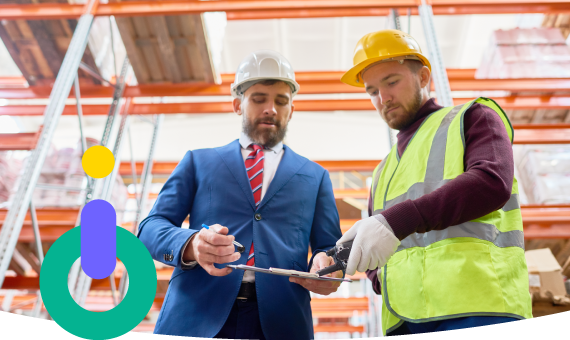How to Prepare a Foolproof Safety Checklist for Construction Sites? [Downloadable PDF]?


- Published On: 25.05.2023
- EHS Software

The construction sector involves large projects, tens to hundreds of thousands working on them, and incredibly high stakes. According to a 2018 OSHA report, the construction industry accounted for 21.1 % of all private-sector work-related deaths. As a result, ensuring safety is of the most significant importance here.
As a result, safety inspection checklists are paper or digital forms used by safety officials to assess and identify workplace hazards that may damage people, processes, or the environment.
Pre-work, quality control, project planning, and other checklists are designed for the construction industry. However, given the nature of the labor involved in the construction industry and the considerable dangers, the ‘Construction Safety Checklist’ is critical.
On construction sites, a safety checklist specifies all jobs that must be completed with care. Engineers and supervisors can use it to keep their work safe. It has been used over time because it dramatically helps minimize the risk of accidents during work. This checklist is essential for business owners and supervisors because it provides a way to prioritize safety on construction sites.
A safety questionnaire is a list of things that must be done to make the building site safe, and it outlines the steps that must be followed to avoid injuries or property damage. When using a safety checklist, you should ensure that each task listed is done carefully and thoroughly. If one study is overlooked, all remaining ones will be rendered useless.
A safety checklist aims to ensure that tasks are being done correctly and not just merely the paperwork. Workers must contribute to creating and maintaining a list to do this. Workers are more likely to grasp their function and ensure they do what they need to accomplish on construction sites if they participate in formulating and adjusting checklists.
A Foolproof Safety Checklist Would Include the Following Topics:
Hazard Identification
Hazard identification identifies potential safety issues throughout the building process and ensures that safeguards are followed. Hazard identification should include possible injuries and the destruction of property. This type of accident should be reported to the site supervisor and the wider industry to prevent another.
Preventive Measures
Preventive measures need to be taken before an accident on a construction site. For instance, before a truck loads up power tools, workers must keep all their safety equipment ready. This precaution could also involve covering exposed machinery parts during changes or storing them in cabinets.
Risk Assessment
A risk assessment evaluates the possible consequences of a specific type of accident. Risk assessments are usually used to determine which accidents are more likely to occur and then develop the necessary precautions to prevent them. Risk assessments are part of controlling the safety of a construction site.
Prevention Measures
Prevention measures refer to the steps that need to be taken to prevent accidents on construction sites. Hazard identification needs to come before this because if you do not know what kind of accident you are trying to avoid, it will be challenging to devise proper precautions.
Resolve Hazardous Issues
Hazardous issues refer to what needs to be done to prevent accidents. Usually, these precautions involve fixing a specific problem that could lead to an accident. This can include replacing machinery parts, changing the way something is done, or installing safety devices.
Clearance Zone
A clearance zone is a construction site where the work cannot be done. It can be used to contain and protect the work that needs to be done when an accident could occur. The clearance zone is essential for all workers because it will be too late for them to warn people about it once an injury occurs.
Emergency Plan
An emergency plan is about creating a plan for the possible outcomes of an accident. Depending on the type of accident that could prove to be hazardous, you need to create an emergency plan that helps ensure the safety of construction sites and workers. Accidental harm can also be prevented with the use of a preparedness strategy.
Checklist for the Final Time
A final checklist test is used to prevent accidents on construction sites by ensuring that no errors were made while creating and maintaining it. This test allows workers to know whether or not a list has been completed correctly. If it is not done correctly, they can go back and check whether or not all tasks are perfectly done and confirm whether or not they must be updated.
The Most Effective Techniques to Create a Construction Site Safety Checklist that is Foolproof are:
Before Beginning a Project, Conduct a Safety Meeting
The first part of this conference will be an overview of the importance of safety for all team members, and then there will be a look at the data from the construction site. Workers can also inquire about the work performed at the location and receive responses to their inquiries. Safety checklists have effectively reduced dangers and kept workers safe on construction sites.
Work with a Safety Officer
This officer should be an extra pair of eyes when looking for possible dangers. The safety officer will assist in keeping workers safe and preventing accidents by checking if the machinery is in good condition or preventing them from doing something unsafe.
Involve the Workers in the Creation of the Checklist
Workers must be included in creating a safety checklist, which should be developed by those who will use it and completed by everyone on the team. By writing your safety checklists, you are more likely to know what they need to include and whether or not they are being correctly completed and modified as time goes on.
Go Over the Safety Checklist Carefully
Make sure that all workers who will be involved in the project go over the safety checklist before beginning work. This will allow them to know what to do if an accident happens and whom they have to contact after it occurs. This information ensures they can quickly react if an accidental injury or property damage occurs.
Clear all Safety Issues Before Starting a Project
By clarifying all the safety issues discussed during the meeting, workers get to know what they will be doing on the site and can ask inquiries if necessary. It is critical to resolve these issues because it allows employees to understand their roles and responsibilities better.
Make Sure That the Safety Checklist You are Using is Complete and Up to Date
The safety checklist must be a full-proof checklist that includes all the necessary things to do on a construction site. It has to be complete and up to date because if not, it will be useless in saving lives. You must update your safety checklist once yearly to be valid.
Train Everyone Before Work Begins
Safety training can help prevent accidents from occurring on construction sites. It is essential to conduct this training before work begins, and any team member can do it. The best way to prepare your workers for all possible dangers is to ensure that they are trained and aware of what they must do in case of an accident.
Ensure that the Proper Equipment and Procedures are Used
The right equipment and procedures are essential for construction sites because they ensure workers have the proper materials and items to work carefully. This will save time, but it will also ensure that accidents do not occur because workers do not have the right tools or materials needed for an activity.
At all Times, Work in Designated Areas
Every project has its own set of processes to follow if work is carried out in one of the surrounding areas. It is essential to consider these procedures carefully because it helps you avoid accidents and injuries from happening because of how a particular activity is handled.
There Must be Sufficient Room for Everyone to Move About Independently
It is necessary to ensure that each person who works on a construction site has enough space to do their job without being in the way of other workers or equipment. The same goes for all workers because they cannot pass each other. They will not be able to observe what is going on at their location, either, which will increase the likelihood that an accident will take place there.
Kept the Area Clean and Well-lit
Every construction site has a defined environment. All workers must be aware of their surroundings to understand where they are working and doing. It is also important that everything that needs to be done on a construction site is given enough attention so as not to cause an accident because there will be more chances of it happening when specific surroundings are neglected.
What is the Significance of Creating a Complete Safety Checklist for Construction Sites?
Safety checklists are proven to be very effective in helping minimize health and safety risks. The personnel working on a project might use it as a guide to ensure they know what must be done and how it must be done. It is also essential that workers know what is required to stay safe. At the same time, safety checklists ensure workers understand how they could get help if an accident does happen.
Workers on a building site must take measures by erecting temporary fences to keep them safe. They also have to create a safe environment for themselves and the public who are passing by. It is essential to know how to use proper procedures to protect the workers from accidents and injuries on a construction site.
How can You Ensure that a Building Site Safety Checklist is as Comprehensive as Possible?
A safety checklist is considered thorough only when everything needs to be included. It should have information on what job is being done and who does it, and instructions on how it is completed. It must cover all of the essential processes that workers must understand before commencing a project and ensure that the jobs are simple for all project participants.
Safety checklists are essential, especially on construction sites, because they ensure that all the necessary steps are included. This will ensure that workers are not unaware of what they need to do in case an accident occurs and how they can get help quickly. It makes sure that each worker knows what to do to prevent all the accidents.
How to Check for a Full-proof Safety Checklist for Construction Sites?
Anyone familiar with the correct way to utilize a checklist is capable of checking the safety checklists. It is a simple process that has to include all the necessary things involved in a project. Once the construction site is done, things that need to be included are considered, and there is an assurance that safety will be considered.
Safety checklists are helpful, especially on construction sites, because they ensure that all the information needed to conduct activities on a construction site is included in the checklist. They assist workers in understanding what they must accomplish and how to perform it while ensuring their safety while on the job.
It effectively minimizes health and safety risks and helps ensure safety during each activity at a construction site. A safety checklist has to be detailed for there to be no room for excessive errors or damaged materials on the construction site.
Conclusion
A safety checklist can be used as a guide by anyone who knows how to use this document properly. It is essential to consider every detail so as not to have any accidents that could cause injuries to workers. A well-made construction site should not cause casualties or damage to the building workers.
When creating your safety checklist, it is critical to be aware of the factors that must be considered. And ensure that your construction team is given everything they need to complete the project successfully.
- 25.05.2023

Businesses can obtain certification in a standard for occupational health and safety management in order to prevent and reduce onsite work accidents…

OSHA’s record keeping rules require employers to maintain accurate and detailed records of workplace injuries and illnesses.

The primary goal of any strategy is to prevent accidents or injuries caused by the employer’s or employee’s carelessness or bad judgment. Injury prevention can be accomplished…